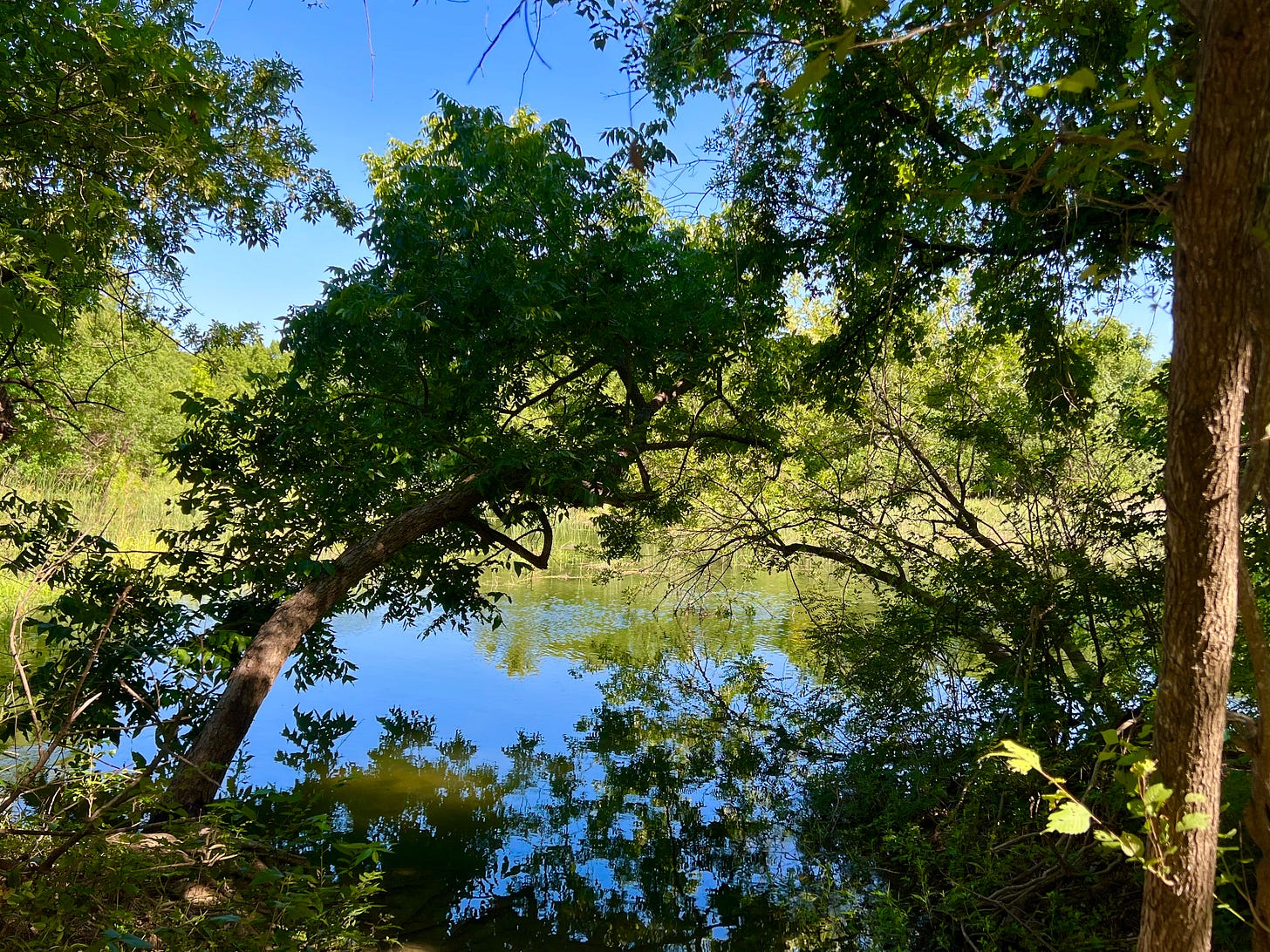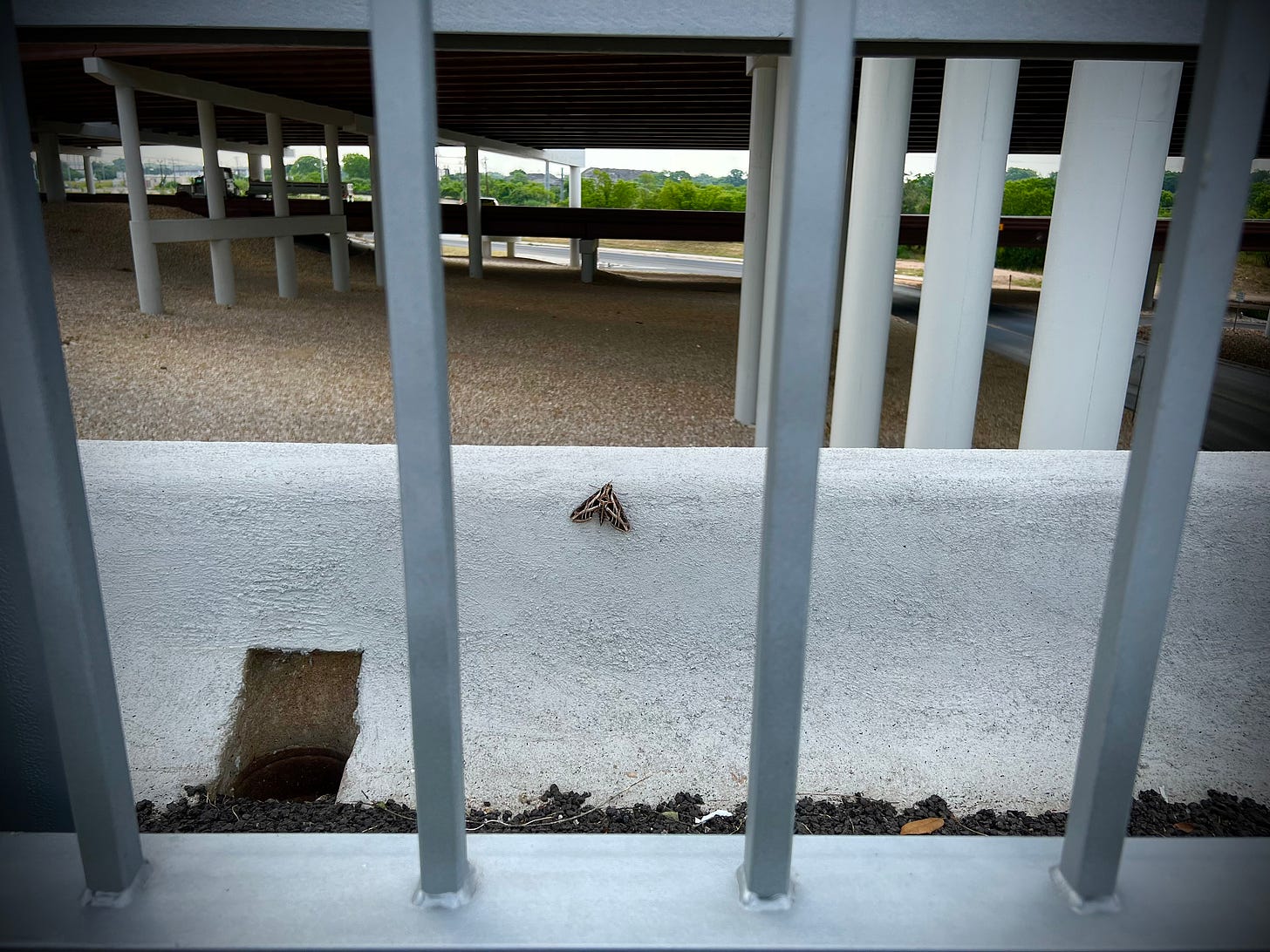Nomads of the Anthropocene
The first sunflowers of the summer bloomed in our yard on Saturday morning, opening up at daybreak to suck up the solar energy of a triple-digit June day, the sort of day that used to be mostly reserved for August. It always amazes me how tall they grow on how little water, evolved to vertically outcompete the grasses of the prairies and now adapted to thrive in the urban interstices where the mowers don’t go. The front page of the Sunday paper the weekend before had been splashed with a huge picture of one of our drying-out lakes and headline portents of a hothouse season fueled by chronic changes in the temperatures of the Pacific Ocean. The kind of coverage that gets you thinking it may never really cool off again.
After some preventive maintenance on our home air conditioning, I went for an urban trail run before it got too hot to do so, following the path the earth movers made while terraforming the giant berm where the old onramp used to go. Big colonies of harvester ants moved in to that denuded zone and staked out spots to colonize just in time for the landscape contractors to reseed it with a mix of invasive and native species. They’re big ants, big enough to see and avoid as you run, hopscotching around the foragers that come and go from their deep underground mounds in a hive-mind pattern algorithmically matched with TCP/IP. I don’t know if it’s their early adoption of packet-switching that explains the way they thrive in exurban rights of way, or the fact that we did such a great job of decimating the population of their main predator, the horny toad.
The morning before, one of my neighbors asked me if I have seen any signs of cougars around here. Apparently another one of our neighbors had some friends across the river spot one dragging a deer down the road.
Since they finished the tollway construction, people have started driving their vehicles down into the wildlife preserve under the bridge, finding alternate routes every weekend around the chains the park managers hang between trees to try to block them. One of the rules of the municipal wildlife preserves is no dogs, but no one knows that, and as I found my way along the old jeep roads that a few decades ago were driven by gravel haulers, a hilarious little snub-nosed terrier popped out of the woods and got at my heels, followed by his laughing human companion. When I reached the river, the backwater wetlands were fully flooded with the waters of the daily summer release from the upriver dams. One wonders what strange adaptations the marine life must make to weather those extreme shifts in their habitat as the floodwaters come every morning with the sun.
In the right of way park of bollards and boat ramps under the bridge, I found tiny human footprints in crushed concrete. They seemed strangely atemporal, like some sign of reversion to a simpler life in the ruins of the future. And then I bumped into my friend Phil and his black dog, walking from the abandoned building where they squat, headed for a morning swim in the river. We got to talking about books, including J.A. Baker’s The Peregrine, which I had given Phil a copy of last Christmas. He dug it, and was regretting that he had given it away to a guy he was partying with.
My wife and I had run into Phil the Sunday before, pushing our daughter in the stroller she has recently rediscovered the palanquin-like pleasures of, but not had time to do more than say hello. It’s a curious thing to catch up with the sort of friend you can only talk to when you happen to run into each other out in the world. As we stood there under the bridge on Saturday, I tried to inquire about his welfare without pissing him off, asking if he can stay cool enough in his squat, and he assured me he’s comfortable enough. We got to talking about a 1990s Larry McMurtry book he had just read, and then a discussion of the joys of writing letters got him remembering the copy of Dracula he found on a friend’s parents’ mantle somewhere in Connecticut in the 1980s, and his discovery therein of the epistolary novel.
Before we ran into Phil that Sunday before, as we walked along the bike lane we were passed by a lone cyclist who telegraphed his approach blasting speed metal from a tiny little speaker. When I turned to look behind us, I saw a middle-aged white guy with wizard beard, piercings, a bit of a scowl—and a big sword. A cutlass, specifically, slung in a scabbard across the small of his back, with a samurai-style combat knife sheathed at his belt and several Batman-grade ammo pouches around it. In my memory, he has a cigar or a pipe in his mouth, but I suspect that is a projection of his piratical impression.
When we got up to the bridge, there he was again, stopped to take in the view with his music still blasting. That wild green river, flowing like an apparition from some other time while the new towers of downtown glistened in the background. A big heron appeared in the frame, flying slowly toward us with dinosaur grace, making time slow down as we watched it approach. Straight at the dude, it seemed, until it suddenly banked, circled down and alighted on a riverine willow.
On the way back, I spotted a sphinx moth at rest on the concrete edge of the bridge. A big moth, too big to really hold in your hand, but rendered tiny by the monumental structures there where the highways and roads converge at the elevated river crossing. I remembered how Phil told me once that he found his squat when he crossed that bridge after walking back here from Missouri many years ago. And then I got to wondering whether regular encounters with men living like survivors of an apocalyptic collapse might be a sign of an ascendant future more evenly distributed than we realize. One where walking to Missouri on emptied highways is a perfectly sensible thing to do. As long as you head out in the daylight, when the lions who rule the ruins are at rest.
Reading roundup
I wrote about an earlier visit to my friend Phil’s squat in this post from January 2, which also has shots from the first rolls of film I’ve been shooting since retrieving an old Canon F-1 from my parents’ basement last Thanksgiving.
For more on the secrets of the Anternet, start here.
And for more on the post-colonial ecological history of the Texas horned toad, an animal reduced to rarity in the wild because of its popularity as an involuntary human familiar, check out this piece at Texas Monthly.
This week’s notes are brief, as I’m busy trying to finish another project this weekend, but a couple of pieces to note:
Over at the London Review of Books, a fascinating Ben Crair piece on the evolutionary history of songbirds, reviewing The Largest Avian Radiation: The Evolution of Perching Birds, or the Order Passeriformes by Jon Fjeldså, Les Christidis and Per G.P. Ericson.
And at Gothamist, an amazing photo tour by Nathan Kensiger of the edgelands of Staten Island’s Arthur Kill, soon to be redeveloped as wind farms.
Next weekend, our friend Pepe Rojo of Tijuana and his colleague Grant Leuning of San Diego will be bringing the Comité Magonista Tierra y Libertad to West Texas. With luck, we will be there with them.
Field Notes will be off next week, in the field. Stay safe, and keep cool.











A damned privilege, as always!
Another great read. Thank you for voice and intellect.